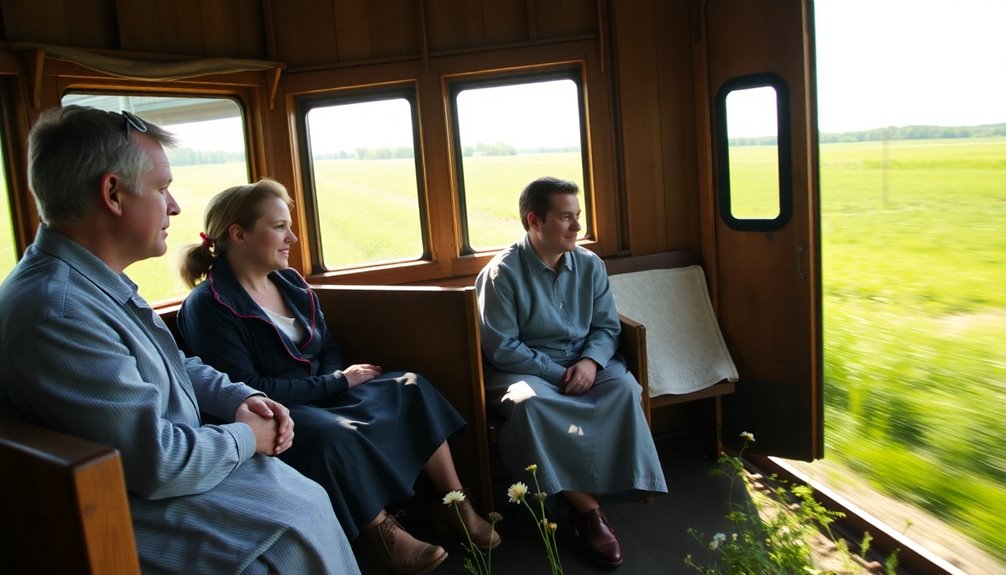The Amish ride trains mainly because it aligns with their values of frugality and simplicity. Trains are a cost-effective way to travel long distances without the individualism tied to cars or airplanes. This choice fosters community connections, as they often share rides with non-Amish friends or hire drivers for longer trips, reinforcing social bonds. Trains also provide a slower pace, encouraging interactions with fellow travelers while appreciating the landscape. By embracing these travel methods, the Amish highlight the importance of shared experiences and resourcefulness. There's plenty more to explore about their unique lifestyle and travel choices.
Amish Travel Methods
When you think of Amish travel methods, the iconic horse and buggy often comes to mind. However, when it comes to Amish travel long distances, they employ a variety of other methods that align with their values of simplicity and community.
In regions like Pennsylvania, you might see Amish individuals boarding trains, particularly Amtrak routes and coal trains, for necessary journeys. This choice allows them to travel further while remaining connected to their communal lifestyle. Many Amish travelers appreciate the cost-effectiveness of train travel compared to other long-distance options, making it a practical choice for their needs. While air travel is technically permitted, it's rarely used due to its connotations of individualism and luxury, which contrasts with Amish principles. For essential long-distance trips, many Amish families hire non-Amish drivers or accept rides from friends, reinforcing their community bonds while ensuring access to important appointments or business matters.
In some communities, bicycles are also an option for shorter distances. This form of travel promotes physical activity and social interaction, although acceptance varies among different Amish groups. Additionally, their choice to utilize conscious consumerism fosters a sense of community while minimizing their ecological footprint, reflecting their commitment to financial health in managing resources effectively.
Horse and Buggy
When you think about Amish transportation, the horse and buggy stands out as a symbol of their commitment to tradition and simplicity. This method not only reflects family values through its customization but also fosters a deeper connection to their heritage. As you observe the leisurely pace of travel, you'll notice how it encourages community interactions and appreciation of the surroundings. Additionally, this mode of transport aligns with sustainable delivery practices that prioritize minimizing environmental impact. This choice exemplifies a commitment to ethical shopping practices that contribute to a more equitable and just society, as it echoes the principles of conscious consumerism that promote thoughtful purchasing decisions.
Traditional Transportation Method
The horse and buggy stands as the primary mode of transportation for the Amish, embodying their commitment to simplicity and tradition. This method allows you to travel at a leisurely pace, giving you the chance to appreciate the beauty of the surrounding landscape. As you move through the countryside, you can engage with your environment in a way that modern vehicles often prevent.
Customization plays a significant role in how families express their values and personalities through their horse and buggies while still adhering to communal standards. Whether it's a unique color or specific accessories, each buggy reflects the family's identity.
Additionally, horse and buggies are practical, easily accommodating picnic and storage baskets, ensuring that you have what you need for your journeys.
Rejecting cars as status symbols reinforces the Amish belief in humility. The horse and buggy symbolizes a deep connection to their cultural heritage, prioritizing community over individualism.
Community and Family Values
Traveling in a horse and buggy creates a unique bond among Amish families, reinforcing their community and family values. This slow-paced mode of transportation encourages you to connect more deeply with your surroundings and those riding alongside you. As you journey together, conversations flow more naturally, fostering a sense of closeness that fast cars often hinder.
Customization of your horse and buggy reflects your family's personality, showcasing creativity while emphasizing humility. Unlike cars, which can spark status competition, the horse and buggy symbolizes a rejection of vanity, prioritizing simplicity and shared values.
This commitment to community interdependence is evident when you rely on one another for rides or assistance. Each trip becomes an opportunity to strengthen relationships, as you're not just traveling; you're engaging with your neighbors and building a support network.
In this way, the horse and buggy doesn't just serve as transportation; it embodies the Amish way of life. By prioritizing family and community, you create an environment where everyone contributes, ensuring that values of cooperation and unity thrive.
This is how the Amish cultivate a rich sense of belonging and shared purpose.
Connection to Heritage
Riding in a horse and buggy isn't just about getting from point A to point B; it's a journey steeped in tradition that connects you to the Amish heritage. For you, this primary mode of transportation embodies the Amish community's commitment to simplicity and traditional values.
As you travel at a leisurely pace, you can truly appreciate the rural scenery, reinforcing your bond with the agricultural roots that define this lifestyle.
Each horse-drawn carriage you see can tell a story, as families often customize them to reflect their values and personality, showcasing the unique identity of their community. In avoiding cars, which are often seen as status symbols, you embrace humility and reject vanity, key tenets of Amish beliefs.
This choice serves as a powerful reminder of your commitment to maintaining cultural heritage while resisting the pressures of modern society.
In every ride, you experience more than just transportation; you reconnect with history and the values that have shaped the Amish way of life.
This deep-rooted connection to heritage through horse and buggy travel enriches your understanding of simplicity and frugality, essential lessons for today's world.
Rides From Non-Amish Friends
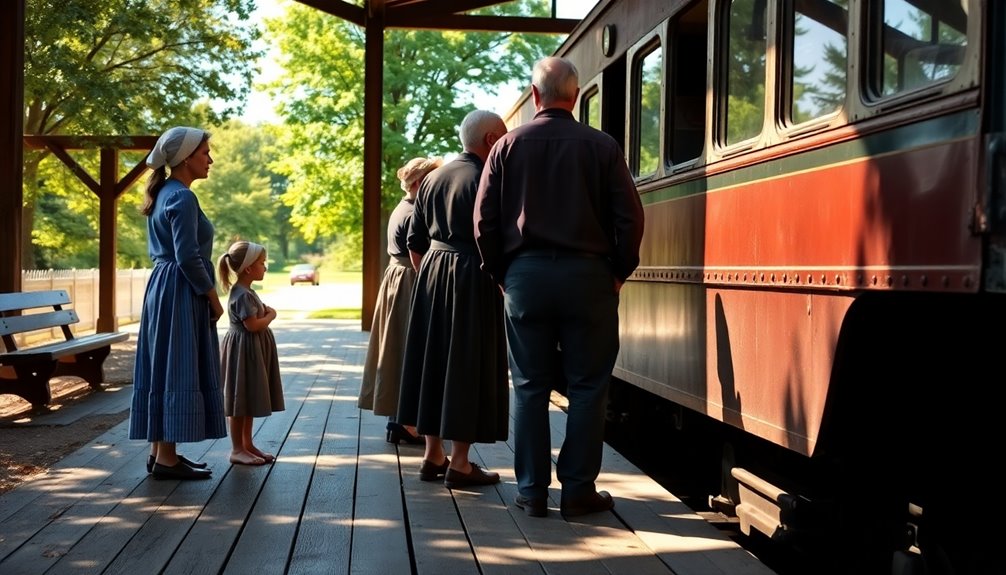
When you think about how the Amish navigate their transportation needs, rides from non-Amish friends stand out as a key solution.
These arrangements not only enhance community bonds but also showcase gratitude and reciprocity, as Amish individuals often offer gas money or small gifts in return. This practice exemplifies their commitment to frugal living, which aligns with the values of simplicity and resourcefulness they uphold. Furthermore, this approach reflects their ability to streamline small business expenses through effective resource management.
This flexible travel approach allows them to maintain their values while extending their reach beyond horse and buggy limitations. Additionally, this practice reflects a broader trend of enhanced accuracy and organization in managing resources effectively.
Community Bonds Strengthened
Many Amish individuals rely on rides from their non-Amish friends for long-distance journeys, showcasing their commitment to strengthening community bonds. This practice isn't just about getting from point A to B; it reflects a deeper relationship-building effort.
When you see Amish travelers seeking rides, you might notice them offering to contribute to gas expenses or presenting small gifts as tokens of appreciation. These gestures reinforce social bonds and highlight the mutual respect between communities.
Accepting rides from non-Amish friends allows Amish individuals to engage with the broader society while staying true to their traditions. This interaction promotes cooperation and interdependence, benefiting both Amish and non-Amish community members.
By relying on each other, they create a support system that transcends cultural boundaries. The flexibility that comes from these rides enriches their lives, making long-distance travel feasible while also fostering connections that mightn't have existed otherwise.
Ultimately, these shared experiences lead to community bonds strengthened, demonstrating that even in their unique lifestyle, the Amish value relationships and collaboration. Through these interactions, they cultivate a network of support that enhances their sense of belonging and reinforces their values.
Gratitude and Reciprocity
Gratitude and reciprocity lie at the heart of the Amish practice of accepting rides from non-Amish friends. When you see an Amish family hopping into your car for a long-distance trip, it's not just about convenience; it's about building and maintaining strong community ties.
The Amish often express gratitude for these rides through simple gestures, like offering to pay for gas or presenting small gifts. This reinforces the principle of reciprocity, showing that they value the help they receive.
By utilizing rides from non-Amish friends, Amish individuals keep their commitment to simplicity while expanding their travel options. They can attend medical appointments or family gatherings that would otherwise be difficult to reach by horse and buggy.
This practice highlights a profound sense of community interdependence, where social bonds take precedence over individualism.
Every ride becomes a shared experience, deepening the relationships between Amish and non-Amish friends. It's a reminder that gratitude and reciprocity foster a supportive network that benefits everyone involved.
Flexible Travel Solutions
Accepting rides from non-Amish friends serves as a practical solution to the travel challenges faced by Amish individuals. While Amish ride bicycles for short distances, longer trips often require more flexible options. By relying on non-Amish friends for transportation, they can access essential services like medical appointments or family visits without straying from their values. This practice fosters strong community ties and reinforces interdependence among neighbors.
When accepting rides, Amish individuals typically compensate their friends with gas money or small gifts, showcasing their gratitude. This exchange not only reflects their appreciation but also highlights the cooperative spirit central to Amish life.
Utilizing non-Amish drivers provides the necessary flexibility to reach destinations that aren't practical by horse and buggy, allowing them to navigate modern life while adhering to their principles of simplicity.
In this way, the acceptance of rides from non-Amish friends exemplifies the Amish commitment to community support, demonstrating that even in a world that often feels disconnected, meaningful relationships can thrive.
It's a perfect blend of tradition and practicality, ensuring that they can balance their lifestyle with the demands of contemporary society.
Hiring Drivers
When the Amish need to travel long distances, they often turn to hiring drivers, a practical solution that balances their community values with the demands of modern life. This approach is particularly common for medical appointments or business-related travel, allowing them the flexibility they need while preserving their lifestyle. By utilizing tools like expense tracking, they can effectively manage their travel costs while adhering to their frugal principles. Many freelancers also benefit from expense tracking apps, which help in organizing their finances and simplifying expense management.
By arranging payment for hired drivers by the mile or hour, they keep travel costs manageable and transparent.
As they commence on these journeys, Amish travelers typically pack snacks in traditional bread boxes, ensuring their cultural practices remain intact even when using modern transportation methods. Hiring drivers extends their travel range beyond what horse and buggy can provide, making necessary trips feasible without straying from their principles. Moreover, this method of travel strengthens community ties, as it often involves local non-Amish individuals. These interactions foster relationships and mutual assistance between the two groups, enriching both communities. Additionally, they often utilize bill tracking tools to manage transportation budgets effectively, ensuring they remain financially organized.
Air Travel Considerations

When you think about air travel, consider how the Amish prioritize community over individualism. Booking flights can be a hassle that disrupts their close-knit lifestyle, making it less appealing. Instead, they often opt for ground transportation, which aligns with their values of simplicity and togetherness. This preference for simplicity mirrors the benefits of personalized shopping experiences that AI offers, enhancing engagement while maintaining a focus on individual needs. Additionally, their choice to avoid the complexities of air travel reflects a broader commitment to eco-friendly options that reduce unnecessary waste and stress. Furthermore, just as AI-driven recommendations can create tailored experiences that enhance customer satisfaction, the Amish seek to cultivate environments that foster strong communal bonds.
Community Over Individualism
Many Amish communities see air travel as a stark contradiction to their values of frugality and community. They prioritize strong connections and shared experiences over individualism, which makes air travel less appealing. While technically allowed, the Amish value transportation methods that keep families together and maintain their close-knit relationships.
Here are a few reasons why air travel doesn't align with Amish values:
- Individualism: Air travel often promotes a sense of separation, which conflicts with the Amish emphasis on community.
- Complexity: The planning and coordination for flights, such as booking and managing boarding passes, feels too complicated and out of sync with their simple lifestyle.
- Family Separation: The potential for being apart during flights raises concerns, as the Amish cherish togetherness.
- Preferred Modes: Traditional transportation methods like horse and buggy or trains resonate more with their communal values, reinforcing their commitment to shared experiences.
Ultimately, the Amish way of life thrives on the bonds of community, making air travel a less favorable choice. Their focus remains on togetherness, simplicity, and frugality.
Booking Challenges Faced
Air travel presents significant booking challenges for the Amish, who typically shy away from this mode of transportation. This reluctance stems from their values, which prioritize community and simplicity.
When you consider the logistics of booking a flight, it becomes clear why air travel is rarely chosen. The process requires coordinating travel plans, purchasing boarding passes, and adhering to strict schedules, which can feel overwhelming.
Moreover, air travel often leads to family separation—something that contradicts the Amish emphasis on togetherness. You might find it difficult to grasp how this separation conflicts with their communal values.
While technically permitted, flying doesn't align with their lifestyle of frugality, as they prefer traditional means of travel like horse and buggy or hired drivers.
The booking challenges faced by the Amish serve as a reminder of their commitment to cultural values. Maneuvering through airports and flights isn't just a matter of convenience; it's about maintaining their identity.
For the Amish, the complexities of air travel simply reinforce their preference for a lifestyle that emphasizes connection, simplicity, and community over individualistic pursuits.
Preference for Ground Travel
Although some may see air travel as a convenient option, the Amish firmly prefer ground transportation for its alignment with their values of simplicity and community. Air travel often feels too individualistic and luxurious to them, which is why they generally avoid it. The separation of family members during flights contradicts their emphasis on shared experiences.
Instead, they choose methods that foster togetherness and align with their lifestyle. Here are some reasons for their preference for ground travel:
- Community Focus: Ground travel allows families to stay together, reinforcing their commitment to community-oriented living.
- Simplicity: Avoiding the complexities of air travel helps them maintain a straightforward lifestyle.
- Shared Experiences: Traveling by train or hiring drivers encourages bonding moments, aligning with their values.
- Minimal Technology: Their preference for ground travel reflects a desire to limit reliance on modern technology, promoting a simpler way of life.
Social Dynamics on Trains
Train travel opens up a unique social dynamic, fostering interactions that often transcend socioeconomic, racial, and cultural boundaries. For Amish people, this setting becomes an opportunity to mingle with diverse fellow travelers, creating unexpected connections.
As you settle into your seat, the communal arrangements invite conversations that reveal personal stories and experiences. The relaxed atmosphere encourages you to share intimate details of your life, while also listening to others. You might find yourself seated next to a veteran reflecting on their service or someone facing personal hardships, offering insights into the resilience and challenges present in society. These interactions enrich your understanding of the world around you.
Moreover, the slower pace of train travel allows for deeper engagement with both the landscape and your fellow passengers. The journey becomes more than just a means of transportation; it transforms into a tapestry of shared experiences and cultural reflections.
Personal Stories and Insights
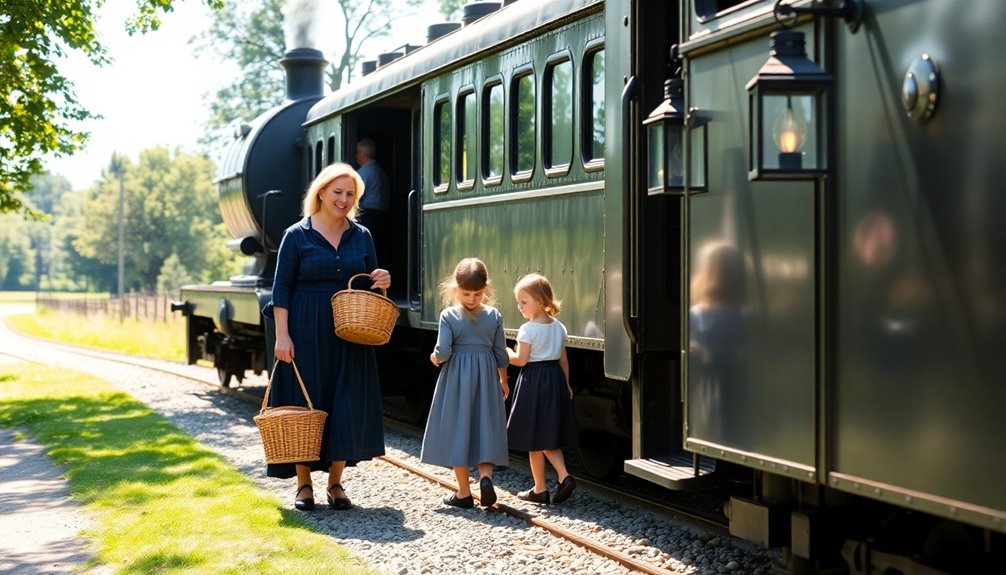
Traveling on the rails offers a unique opportunity for personal storytelling that enriches the journey for Amish passengers.
The relaxed atmosphere encourages intimate discussions, allowing you to engage with diverse individuals and share personal stories. These encounters foster a sense of community and connection, transforming long train rides into memorable experiences.
Here are four insights you might gather during your travels:
- Resilience in Adversity: Hear inspiring tales from heart-lung transplant survivors, showcasing hope amidst hardships.
- Themes of Loss: Discuss the challenges of loss with fellow travelers, creating a deeper understanding of life's complexities.
- Pursuit of Opportunities: Learn from others about their journeys and the relentless pursuit of better opportunities, revealing shared struggles.
- Cultural Reflections: Engage in conversations that highlight the cultural tapestry of American society, reflecting on the diverse backgrounds of your co-passengers.
These personal stories become a tapestry of shared experiences, enriching your travel experience and offering insights into the resilience and strength found in each journey.
Landscape of Train Journeys
On a train journey, you're immersed in America's diverse geography, where scenic vistas unfold like a moving canvas. As you glide through prairies, mountains, and rivers, each view invites you to pause and appreciate the beauty surrounding you.
The slower pace of train travel allows you to engage deeply with the landscape, encouraging reflection on the journey itself.
Train journeys evoke a sense of wonder, helping you connect with the cultural and natural heritage of different regions. You might find yourself captivated by vibrant urban areas or vast, open fields, each telling its own story.
The hypnotic rhythm of the train enhances this experience, drawing your attention to the passing scenery and making every moment feel alive.
As you traverse America, the landscapes become a part of your adventure, enriching your understanding of the world. You're not just a passenger; you're a witness to the country's beauty, seeing it from a unique perspective that only train journeys can offer.
This intimate connection to the land fosters an appreciation for the simple joys of travel, much like the values cherished by the Amish.
Historical Significance of Railroads
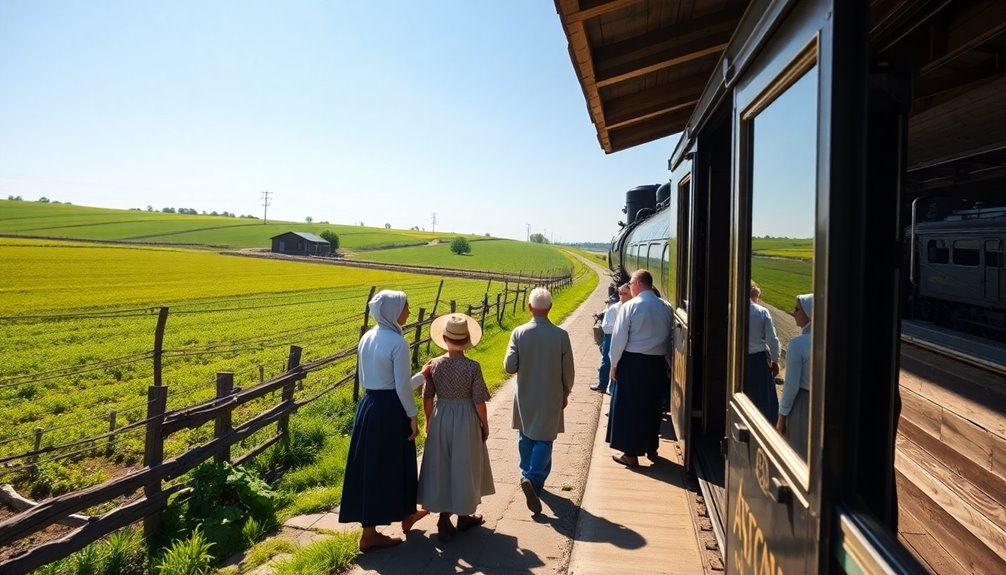
Connecting regions and people, railroads have played a pivotal role in shaping America's historical landscape. The historical significance of railroads extends beyond mere transportation; they were essential for westward expansion and economic growth.
For the Amish, who value simplicity, the train represents a link to a broader world while maintaining their frugal lifestyle.
Here are four key aspects of this significance:
- Westward Expansion: The First Transcontinental Railroad, completed in 1869, connected the eastern and western U.S., enabling settlers to explore new territories.
- Economic Growth: By the 1920s, over 250,000 miles of railroad track fueled industrialization, creating job opportunities and enhancing commerce.
- Cultural Symbolism: Trains evoke feelings of freedom and adventure, often representing exploration in American literature and films.
- Community Development: The sound of trains fostered nostalgia and established towns around rail stations, shaping local economies.
For the Amish, utilizing trains allows them to travel without compromising their values, illustrating how railroads have intertwined with their way of life while contributing to America's rich history.
Modern Developments in Rail Travel
Rail travel has transformed considerably in recent years, making it an increasingly viable option for both commuters and long-distance passengers. Amtrak now operates over 21,000 miles of routes across the U.S., ensuring essential rail services for everyone.
As urban transit systems increasingly rely on trains, you're witnessing a reduction in traffic congestion and a promotion of sustainable transportation. High-speed rail projects are being proposed to enhance travel efficiency and connectivity between major cities, making your journeys quicker and more enjoyable.
With modern amenities like Wi-Fi, comfortable seating, and dining options, train travel has become a more attractive choice. Innovations in technology focus on enhancing rail safety and efficiency, ensuring you can travel with peace of mind.
Sustainable practices are being integrated into operations, minimizing environmental impact while still supporting the economy. In fact, railroads contribute over $70 billion to the U.S. economy annually and support millions of jobs across the nation.
These developments not only make rail travel more appealing but also align with your desires for convenience and sustainability, reflecting a modern approach to transportation. So, next time you think about traveling, consider hopping on a train!
Overview of Amish Lifestyle
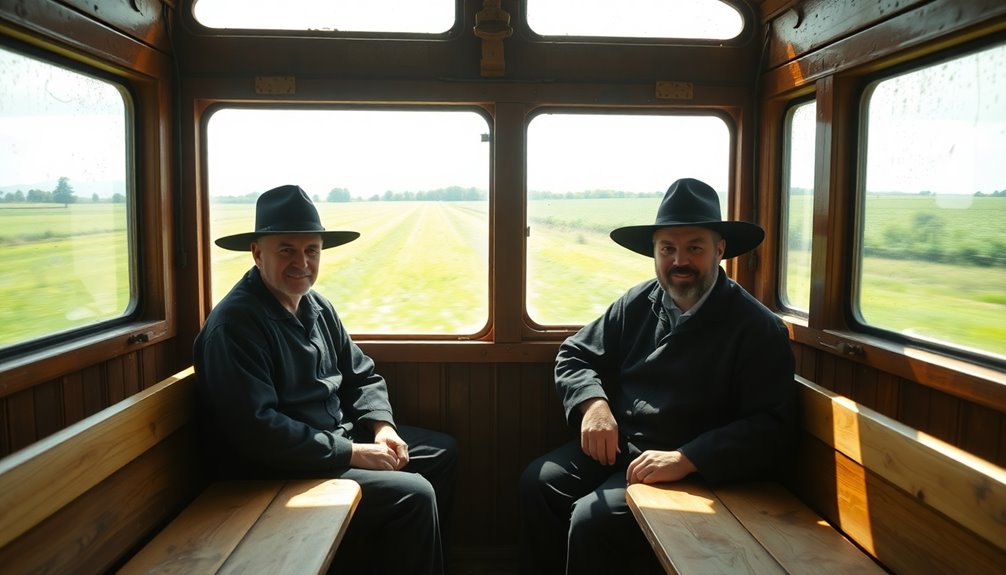
Traveling by train offers a glimpse into different lifestyles, including the rich traditions of the Amish community. The Amish prefer a way of life that emphasizes simplicity, frugality, and a strong sense of community. They reject modern technology, choosing instead to embrace practices that promote self-sufficiency and sustainability.
Here are some key aspects of the Amish lifestyle:
- Traditional Practices: Amish prefer horse-drawn carriages and wood-burning stoves, showcasing their commitment to heritage and sustainable living.
- Homegrown Food: Families prioritize growing their own food and making their own clothing, fostering a sense of interdependence within the community.
- Frugal Living: The Amish minimize waste through reducing, reusing, and repairing items, which leads to a lower environmental footprint.
- Modesty in Dress: Their plain clothing choices reflect a core value of modesty, steering clear of materialism and competition, thereby strengthening community bonds.
Technology and Mental Well-Being
In a world dominated by technology, the Amish way of life offers a rejuvenating perspective on mental well-being. By minimizing distractions from modern devices, the Amish believe they can protect their mental health. Instead of relying on electric appliances, they use manual tools, fostering mindfulness in their daily activities. This approach allows you to engage fully in the present moment, reducing anxiety and enhancing contentment.
Moreover, the Amish prioritize face-to-face interactions over digital communication. This commitment strengthens relationships and builds a robust community support system, which is crucial for emotional resilience. You'll find that these personal connections provide a sense of belonging and stability that technology often lacks.
Living without the constant presence of screens encourages a simpler lifestyle, leading to reduced stress and greater overall happiness. The absence of modern technology enables you to focus on what truly matters: relationships, community, and mental well-being.
Frugality and Environmental Impact
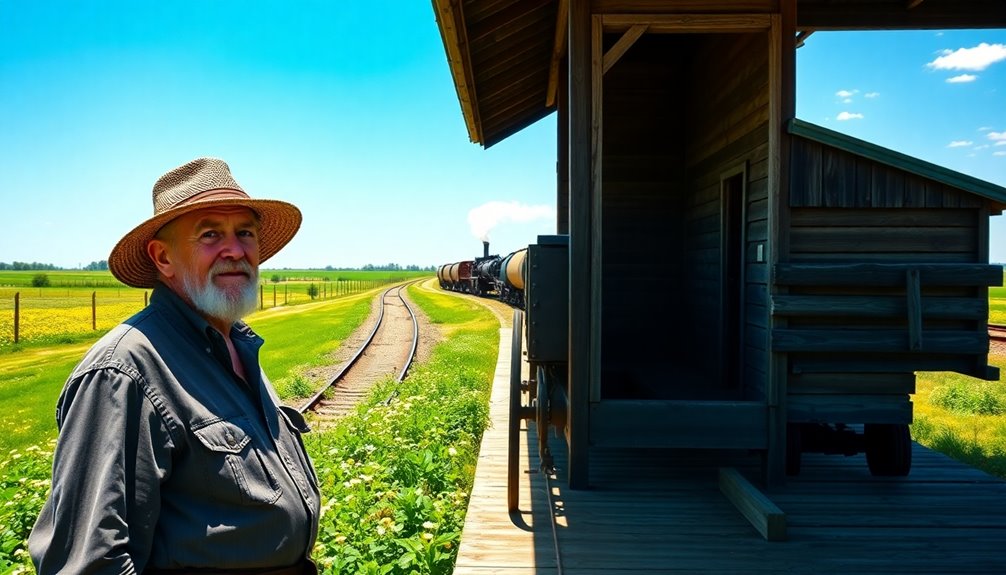
How can frugality lead to a more sustainable lifestyle? When you embrace frugality, you're not just saving money; you're also making choices that benefit the environment.
The Amish exemplify this by prioritizing the reduction, reuse, and recycling of materials. This mindset minimizes waste and aligns perfectly with sustainable living.
Here are four ways you can adopt frugality for environmental impact:
- Grow Your Own Food: Engage in gardening to reduce reliance on commercial agriculture, lowering your carbon footprint.
- Repair Instead of Replace: Fix broken items rather than discarding them; this practice fosters resourcefulness and reduces waste.
- Share Resources: Participate in community sharing programs. Whether it's tools or homegrown produce, sharing minimizes individual consumption.
- Embrace Simple Living: Simplify your lifestyle by reducing unnecessary purchases, which leads to less waste and a lighter environmental impact.
Conclusion
In the end, the Amish way of travel offers a unique perspective on simplicity and frugality. Did you know that over 80% of Amish communities still rely on horse-drawn buggies for daily transportation? This commitment to their values not only reduces their carbon footprint but also fosters a deep connection with their surroundings. By choosing trains and other simple methods, they remind us all of the benefits of slowing down and embracing a more mindful way of living.

